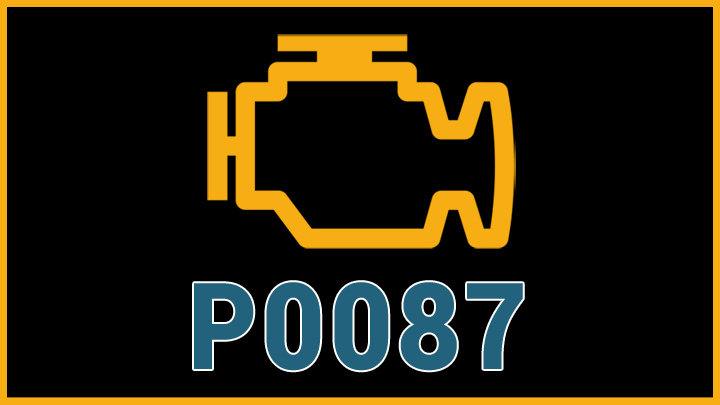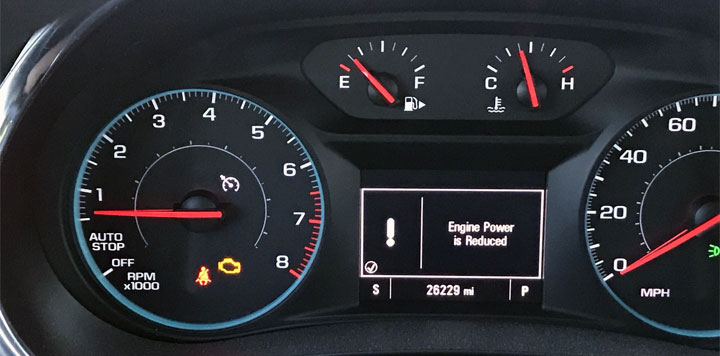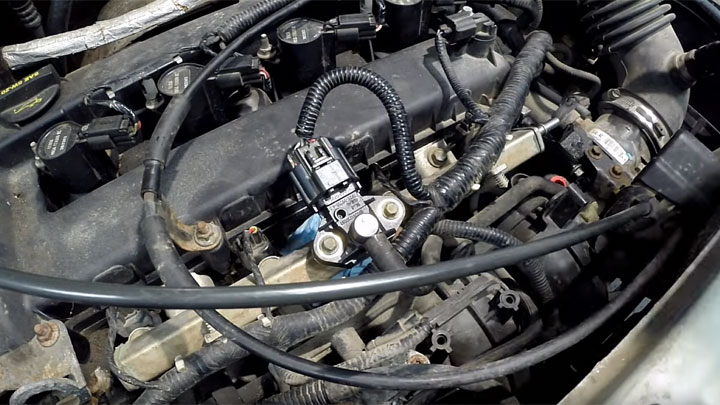P0087 Code (Symptoms, Causes, and How to Fix)
As most motorists are well aware, a vehicle’s engine must receive adequate fuel delivery at all times to sustain operation. When fuel delivery is insufficient, a diagnostic fault code, such as DTC P0087, is often generated.
This fault, in particular, is indicative of lower than expected fuel rail pressures. Read on to learn more about DTC P0087, what causes it, and how to fix it.

What Does Code P0087 Mean?
Many automotive fuel systems feature continuously-energized fuel pumps that supply steady fuel delivery at all times and integrated return-side pressure regulators. However, this is far from the only type of fuel system to exist.
A number of internal combustion engines now utilize return-less fuel systems, where fuel rail pressure is sustained strictly through fuel rail pressure monitoring and pump modulation.
Fuel systems of the sort mentioned above rely upon the accurate measurement of fuel rail pressures by a dedicated fuel rail pressure sensor.
Feedback from this sensor is relayed to the vehicle’s ECM/PCM, where it is interpreted into actionable values. Logic within the ECM/PCM then cues the connected fuel pump driver module to energize the fuel pump as needed to sustain proper rail pressure.
When a vehicle’s ECM/PCM determines that an engine’s fuel rail pressure is critically low, and is not responding to cues for fuel pump energization, diagnostic fault code P0087 is often logged.
This fault will remain active for as long as fuel pressures remain below desired levels. In most cases, overall engine performance will suffer to a noticeable degree in light of these reduced fuel pressures.
Symptoms of Code P0087

A P0087 code is often accompanied by a host of secondary symptoms, some of which tend to be far more severe than others. Those versed in identifying these individual symptoms, stand a greater change of rectifying the issue at hand in a timely manner.
The following are several of the most common causes of DTC P0087:
- Illuminated check engine light
- Random misfires
- Limp mode (reduced engine performance)
- Stalling
- Starting issues
- Excessive exhaust smoke
See Also: Symptoms of a Bad Fuel Tank Pressure Sensor
Causes of Code P0087

The causes of fault P0087 can be wide ranging, and vary in severity. Some of these culprits can prove moderately difficult to pinpoint. Once the root cause of fault P0087 is identified, the matter of repair itself tends to be relatively straightforward.
However, a defective fuel pump and/or fuel pump driver module tend to be among the most common underlying issues.
Other potential causes of diagnostic fault code P0087 include fuel tank damage, fuel line damage, and a clogged fuel filter. Ultimately, the elimination of this fault requires careful visual inspection and mechanical testing.
Is Code P0087 Serious?
Diagnostic fault code P0087 is often regarded as being of moderate severity, due to the fault’s possible negative ramifications to overall vehicle driveability. A fault of this type is often accompanied by misfiring and noticeably reduced engine performance. Issues like this only tend to worsen with time.
Even more troubling is the fact that the symptoms mentioned above often progress to the point of ultimately culminating in intermittent stalling and possible starting Issues. This, in turn, has the potential to leave a motorist stranded, without much in the way of additional recourse, often requiring a vehicle to be towed.
In any event, the root cause of a vehicle’s P0087 diagnostic fault code should be thoroughly diagnosed and repaired as soon as possible. Acting quickly can minimize the chances of additional problems arising and reduce the time your vehicle is out of commission.
Should you feel uncertain about handling the repairs on your own, it’s best to schedule a visit with a reliable automotive repair shop as soon as possible.
How to Fix Code P0087

To help you pinpoint and resolve the cause of your vehicle’s P0087 diagnostic trouble code, follow the steps below. However, it’s always advisable to refer to the manufacturer-specific service manual for your particular vehicle model before attempting any repairs.
#1 – Check For Additional DTCs
Before beginning the diagnostic process, check for the presence of any additional diagnostic fault codes. Any such codes should be thoroughly diagnosed before proceeding.
#2 – Test Fuel Rail Pressure Mechanically
Begin the diagnostic process by checking the affected engine’s fuel pressure at the fuel rail itself, with the use of a mechanical fuel gauge. All pressures recorded should be compared to those specified by the vehicle in question’s manufacturer.
#3 – Inspect Fuel Tank/Lines
Next, if fuel rail pressures proved below acceptable levels, carefully inspect the vehicle’s fuel tank and fuel lines for signs of damage. This should include tracing the vehicle’s fuel lines from their point of mount at the tank, the fuel rail itself.
Any such damage that is identified should be repaired, and applicable fuel pressures should be retested.
#4 – Replace Fuel Filter
In the absence of obvious signs of fuel tank/line damage, the affected vehicle’s inline fuel filter should be replaced. This is especially true if the filter in question has exceeded its specified service life.
Testing of applicable fuel pressures should be checked once again following this replacement.
#5 – Test Fuel Pump/Driver
If fuel rail pressures still remain below the acceptable threshold, qualification of the affected vehicle’s fuel pump and fuel pump driver will be required. The process for accomplishing this will differ from one model of vehicle to the next, and should be carried out in accordance with practices specified by the vehicle in question’s manufacturer.
Failure of subsequent testing will require the faulty fuel pump and/or driver module to be replaced. After replacement has been completed, all applicable rail pressures should be recorded, in order to substantiate the repair itself.
- P0480 Code (Symptoms, Causes, and How to Fix) - Apr 19, 2024
- Car Temperature Gauge Stopped Working? (Here’s Why) - Apr 15, 2024
- Ignition Coil vs Coil Pack (What’s the Difference?) - Apr 8, 2024
